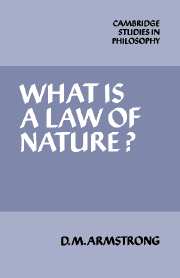Conclusions
Published online by Cambridge University Press: 05 June 2012
Summary
I will try to sum up the main positive theses argued for in this essay.
Laws of nature are dyadic relations of necessitation (or probabilification) holding between universals. They are (higher-order) states of affairs, states of affairs which are simultaneously universals. The instantiations of these universals are the positive instances falling under the law. It is an intelligible notion that a particular first-order state of affairs should necessitate a further first-order state of affairs, yet not in virtue of the universals involved in these, states of affairs. But in a law of nature this same relation of necessitation links sorts of states of affairs, that is, universals. Such necessitations ‘might have been other than they are’, that is, they are contingent. Where one sort of state of affairs necessitates another, then it is entailed, in the absence of further interfering factors (which are always at least logically possible), that the first sort of state of affairs is constantly conjoined with the second sort of state of affairs.
All genuine laws are instantiated laws. Statements of uninstantiated law are to be construed as counterfactuals about what laws would hold if certain conditions were realized. Such statements depend for their truth upon the existence of higher-order laws. Given the higher-order law and the contrary-to-fact condition, then the uninstantiated law may be deduced.
Functional laws are higher-order laws governing those lower-order laws which can be deduced from a functional law after substituting particular values for independent variables.
- Type
- Chapter
- Information
- What is a Law of Nature? , pp. 172 - 173Publisher: Cambridge University PressPrint publication year: 1983



